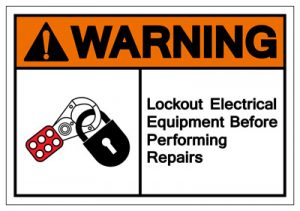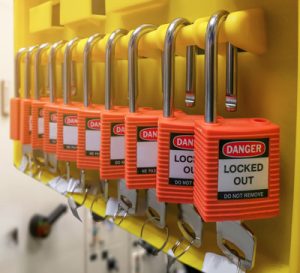Lockout / Tagout (LOTO) as a Component of Repair and Maintenance of Overhead Crane Systems
Lockout / Tagout Procedures Keep Crane Service Inspectors Safe
 Permanent overhead cranes can provide incredible efficiencies in manufacturing or industrial applications. An overhead crane consists of parallel runways with a traveling bridge spanning the gap. The lifting component of a crane (known as the hoist) travels along the bridge. These permanently installed devices may be used multiple times daily in a plant. Periodically though, maintenance or repair of the crane rail, bridge or runway will be required.
Permanent overhead cranes can provide incredible efficiencies in manufacturing or industrial applications. An overhead crane consists of parallel runways with a traveling bridge spanning the gap. The lifting component of a crane (known as the hoist) travels along the bridge. These permanently installed devices may be used multiple times daily in a plant. Periodically though, maintenance or repair of the crane rail, bridge or runway will be required.
Working near ceiling height on an overhead crane system has its challenges, including fall protection for the workers. Worrying that the crane may be started and suddenly move while being maintained is something no one should have on their minds when working from that height. Furthermore, simply contacting the electrical energy source when working can be dangerous or deadly to a worker who touches a “hot” rail.
For these reasons, developing a standardized “Lockout/ Tagout” procedure to prevent accidental starting or electrification of crane rails while in service needs to be established.
What is Lockout / Tagout?
 Lockout / Tagout, or “LOTO”, refers to specific practices and procedures to safeguard employees from the unexpected energization or startup of machinery and equipment, or the release of hazardous energy during service or maintenance activities. A lockout uses a lock to hold an energy isolation device in a safe position and prevents the energization of the machine or equipment. Tagout is when a tag is placed on a piece of equipment to indicate that the equipment being controlled may not be operated until the tagout device is removed.
Lockout / Tagout, or “LOTO”, refers to specific practices and procedures to safeguard employees from the unexpected energization or startup of machinery and equipment, or the release of hazardous energy during service or maintenance activities. A lockout uses a lock to hold an energy isolation device in a safe position and prevents the energization of the machine or equipment. Tagout is when a tag is placed on a piece of equipment to indicate that the equipment being controlled may not be operated until the tagout device is removed.
Within OSHA regulation 29 CFR 1910.147, OSHA requires employers to follow and enforce safety procedures when workers are involved in or around work on machines or equipment that may start unexpectedly and injure nearby individuals. To prioritize worker safety, this regulation exists to eliminate any unexpected startups.
One of the most important parts of a Lockout / Tagout (LOTO) process is to have documented procedures for workers who are actively working with machines or any other equipment where LOTO should be used. The procedures should include the rules, purpose, scope, authorization and techniques to be used. It is also very crucial to have a plan to enforce these procedures.
When building your procedures, the following should be included:
- Purpose and use of the procedure
- Step by step process to shut down, secure and isolate the machine
- Steps for placing, removing and transferring LOTO devices
- Requirements for testing each machine or equipment to validate effectiveness of LOTO devices
- Listing of what the LOTO devices include
- Identification of each LOTO device
- Standardizing the devices within the company including size, shape or color, as well as the format for each LOTO device
- Must be able to withstand the working environment, as well as varying weather conditions
- LOTO devices must be easy to operate
- Clearly readable tags that allow knowledge of who is currently using the device
- Defined warning hazards that could take place if the machine or equipment should regain energy
- A schedule to routinely inspect devices and check LOTO procedures to stay within compliance
- Employee training and communication of LOTO procedures and hazards should be continuous and not limited to new job assignments, new hazards that present themselves or when there are changes to procedures to new energy control
Diversified Fall Protection is the leader installing fall protection on crane rail, bridges and runway systems, and many other industrial fall protection systems.
Combining a Lockout / Tagout system with an installed Horizontal Lifeline for an overhead crane being serviced as part of your safety procedures will help mitigate injuries in a fall from height.
For more information or assistance on any of our engineering, installation or inspection services, please contact us.
Schedule an assessment with Diversified Fall Protection
Contact Us to request a fall safety review

b-1.jpg?width=1368&height=1340&name=Rail%20(175)b-1.jpg)

